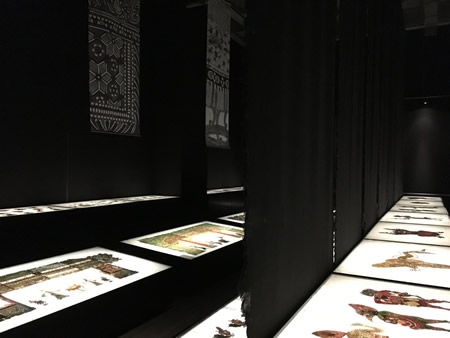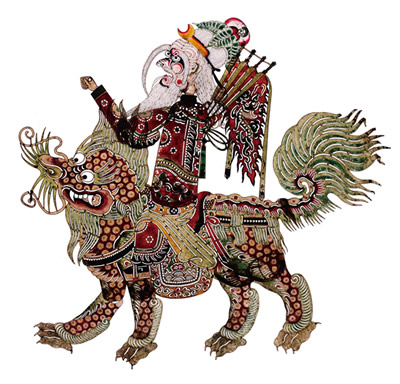中文 ENGLISH
 Shadow play is one of the oldest Chinese opera. Its name “Ying Xi” occurred in literature of the Song Dynasty. Du Cheng Ji Sheng, which was written by Guanpunaideweng, recorded that shadow puppet was carved with white paper by capitals at first, and then was made of colored leather. The stories were familiar with histories from speakers and it is probably true and false in each half. To carve the appearance of integrity for loyal and kind people, and to carve ugly appearance for evils. Basically the Shadow play showed the praise and belittling of citizens. Shadow play which was changed from paper to literature had been quite popular in the Northern Song Dynasty, and stages were built in every lane of different districts in Kaifeng during the Lantern Festival, from Dong Jing Meng Hua Lu, written by Meng Yuanlao.
Shadow play is one of the oldest Chinese opera. Its name “Ying Xi” occurred in literature of the Song Dynasty. Du Cheng Ji Sheng, which was written by Guanpunaideweng, recorded that shadow puppet was carved with white paper by capitals at first, and then was made of colored leather. The stories were familiar with histories from speakers and it is probably true and false in each half. To carve the appearance of integrity for loyal and kind people, and to carve ugly appearance for evils. Basically the Shadow play showed the praise and belittling of citizens. Shadow play which was changed from paper to literature had been quite popular in the Northern Song Dynasty, and stages were built in every lane of different districts in Kaifeng during the Lantern Festival, from Dong Jing Meng Hua Lu, written by Meng Yuanlao.
Shaanxi province is recognized as the birthplace of the Chinese shadow play. Brief History of Chinese Shadow Play and Its Current Situations, which was written by Gu Xiegang who was the modern historian, recorded that the birthplace of Chinese shadow play is Shaanxi province, shadow play is the most prosperous Since the Qin and Han Dynasties to the Sui and Tang Dynasties. Since the Song and Yuan Dynasties to the Ming and Qing Dynasties, the shadow play of Shaanxi had been pretty popular. In modern era, Shaanxi shadow play was throughout places of the northern Shaanxi, Guanzhong, southern Shaanxi and had the high quantity and superior art quality. And the squires had mostly large shadow puppets with high art taste. Every shadow play troupe could perform dozens of plays, even more than hundreds. According to the registration of the shadow play troupes, in the early 1980s, there were over 40 shadow play troupes in Qianyang, a county located in the western area of central Shaanxi. However, the population of Qianyang county is only 110 thousands, and Huaxian had thirty-eight shadow play troupes, Liquan county was the same. Almost every county had shadow play troupes in Shaanxi area. In the various genres of shadow plays during the Ming and Qing Dynasties, thousands of the basic patterns of facial makeup were preserved and handed down from one generation to the next among the shadow play artists. The shadow figures used in the show were mostly handed down from predecessors, many of which were produced in the 18th and 19th centuries.

Chinese Shadow Play is a genre of drama played by operating the silhouettes carved out of leather or cardboard and projecting their shadows on to a screen with a lamplight. The Shadow Play is performed by an artist hidden behind the white screen operating the silhouettes while singing the story to popular local tunes using percussion and string music instruments rich in local flavor, which can express the dramatic plots, the motion of humans, animals, and the changes of natural phenomenon. The artists activate the silhouette figure’s various dramatic actions as demanded by the plot, such as waving a weapon in fight, capturing people on horseback, two troops in confrontation, battling on the field, riding on the cloud, transforming the body, changing clothes, beheading with a blade, falling forward or bending backward, stomping the feet while hammering the chest etc. can be delicately and vividly performed. Upon a source of light, extraordinary skills, sounds and lights effect then further strengthen the expression of shadow puppet art. The performance technology of Shaanxi shadow play is ingenious. And these technologies, stirring, sustaining, pushing, pulling, shaking, twisting, kneading, waving, jerking, flipping etc., achieve the image of the movement, the complex action of the characters and delicate emotional performances, and giving fresh vitality to shadow puppets. Shaanxi Shadow Play formed several branches in the long process of its historical development. It has more than ten different singing tunes: the Old tunes, the Bowl tunes, String-plate tunes, E’gong tunes, Qin tunes and various Daoqing of the south and north.
The design and production of the shadow silhouettes are important processes in the art of Shadow Play. The main raw materials used in the production of shadow silhouettes are cowhide. Shaanxi shadow puppet selects the finest type. Through the exquisite processing just like soaking, scraping, grinding, push, change into the translucent. Then use a specialized push plate to mill the leather with some oil. This will make the surface of the leather shiny, smooth and free from shrinkage. The leather thus processed will become glassy and easy to carve on. After a shadow silhouette is carved, smoothed and polished, it will be colored. The colors used are mostly pure black, red, green, yellow and purple mineral pigments on both sides in multi levels in different kinds of methods. Shaanxi shadow puppet is in high transparency. With light projection, it becomes even more colorful. The craving line of Shaanxi shadow is more elaborated and fluent. The snow pattern and the swastika can show these feature. Besides, the animal leather used are particularly thin, easily to be cont rolled, flat and distortion-resistance.
rolled, flat and distortion-resistance.
The silhouette figures of Shaanxi Shadow Play are divided into the east style and the west style taking Xi'an as the boundary. East Style was mainly popular in Tongzhou, Chaoyi(now Dali county), Huaxian and Huayin in Shaanxi Province, and is the largest number of Qing Dynasty Shadow Puppet until now. Its character's head with height about 1:5 ratio, the stocking feet for male is 11 inch and for female is almost 11 inch. Sculpture is exquisite, modeling is vivid, adornment is rigorous and color is gorgeous. West Style was mainly popular in the west of Xi’an, from Qianxian, Liquan, Xingping until the west of Baoji. The west style silhouette figures are usually massive in size (around 56cm in height) with their usual concise outlines and liberal patterns. Its character's head with height about 1:6 ratio with stretch figure, simple decoration, pure and liberal patterns and lordly. Beyond them, gray Shadow Puppet was special in Shaanxi Province. It was mainly popular in Fuping, Jingyang, Gaoling, Sanyuan, Yaoxian and Liquan of Shaanxi Province in Qing Dynasty. It was developed on the basis of West Style. The lime shadow has special making methods and the preparation of dense were not preach, nobody knows production process. The color of literature was white and translucent with soft touch. It was easily to carve and color. Modeling was exaggeration, carving was perfect and coloring was fine and elegant.
The art of shadow carving in the east style of Shaanxi province are mainly on show in the museum, including figures, fantastic animals, furniture, settings, play scripts and puppet boxes. While appreciating the art of puppet carving, visitors can learn about the ancient costumes, architecture, customs and culture. We expect that more and more people would join us in the study and protection of shadow play, and explore a bright future of it together.
